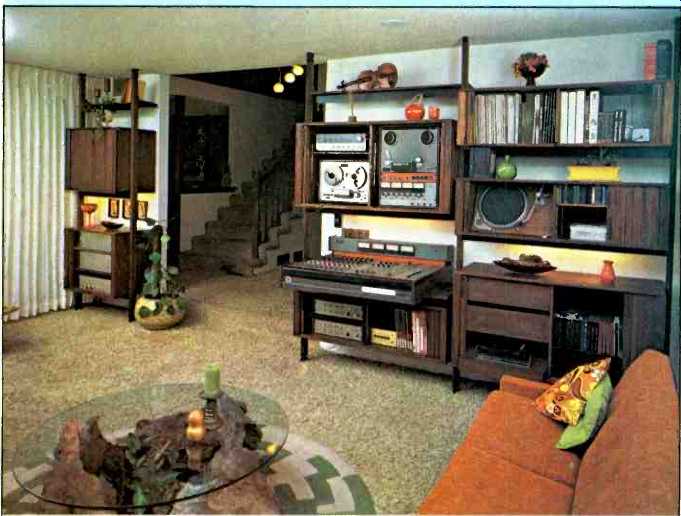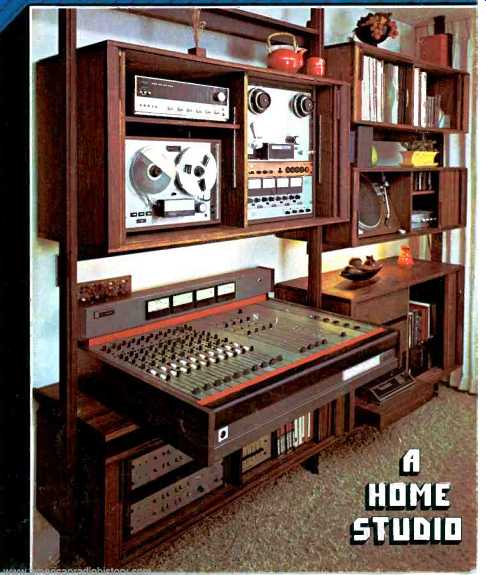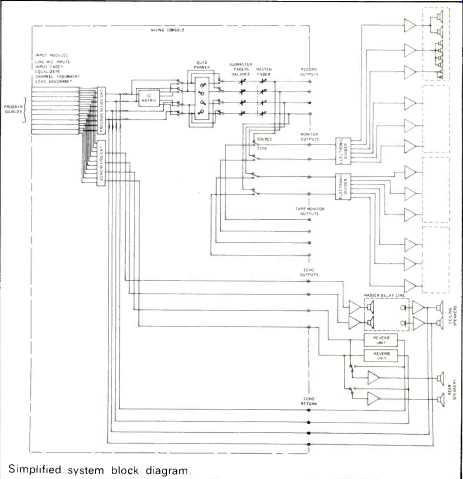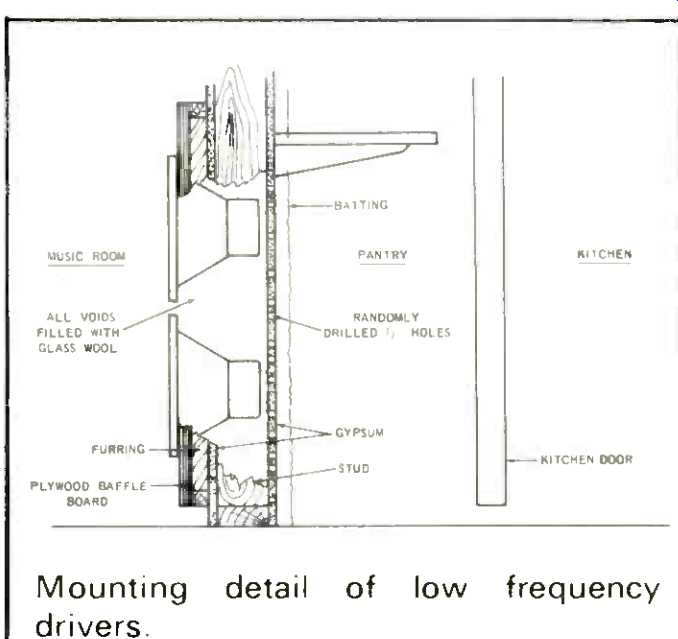

above: A home recording session at the Berg's. The draped wall behind the
performers masks the speaker-studded wall discussed. The recorder/reproducer
is a TASCAM Series 70, mics are Altec M-49's.
This is not a close look at a typical audiophile's equipment because neither this particular audiophile nor his installation is very typical. Arne Berg, formerly director of engineering at TEAC Corporation of America and now executive vice-president of TASCAM Corporation, has (with the kind permission of his wife) turned his living room into an experimental laboratory. What is unique about this experimental laboratory, however, is that it can easily be turned back into a living room. His equipment, much of it scratch built, prototypes, or production models of things he's had a hand in designing, is hidden in walls or behind Barzilay cabinets when not in use. Thus, your view of the room differs depending on whether you're from AUDIO or Better Homes & Gardens.
With almost 25 years in the audio industry, Arne has some exceptional accomplishments to his credit, among the most notable being the development of Reverse-O-Matic and the design of the first commercially available four-channel stereo tape recorder.
Recently we visited the Berg home near the mountains in Los Angeles. At the time the living room/lab was being used for a home recording session. Later we talked to Arne about his system and some of the things he's currently working on.
---- ---- ----
AUDIO: Let's begin with your speaker system. Obviously, you made your own. Did you incorporate some new ideas or did you just feel you could do better than manufactured units?
BERG: I wasn't bent on outdoing the experts in this field. I built the system myself mainly because of a special, self-imposed problem. When I listen to music I don't like to see speakers. I find myself staring at them and they get in the way psychologically. I think that's true of most people. The sound just seems better when the speakers are out of sight. This is a living room as well as a listening room 'so drapes seemed to be the answer. The room is really too small to drape in front of manufactured speaker systems because I wanted a system that produces a lot of acoustic energy at the low end. That usually takes a large system. Instead I've utilized various drivers built into the wall.
AUDIO: I presume then the woofers are baffled by the room behind the wall?
BERG: Yes. The backs of the eight woofers "look into" the kitchen through the pantry via a series of holes. A crossover frequency of 100 Hz permits the otherwise peculiar location. The low cut-off is also important so my wife won't feel like she's making dinner inside a speaker cabinet.
The size limitations of the room also account for the arrangement of other speakers. I have a Madsen delay system, but instead of placing the speakers at the sides I put them in the ceiling.
I have two rear speakers hidden behind the couch for regular quad and I've placed them so they reflect the sound off the bay window back into the room.
The midrange units in the frontal system are arranged in column fashion which provides good dispersion. The space between the studs gives me adequate baffling down to 100 Hz. The tweeters are compression units and are also mounted in column pairs.
AUDIO: What about the absorption effects of the drapes hung in front of the speakers?
BERG: Well, of course there's always going to be a certain amount of attenuation through any material, but I spent a lot of time in careful selection of the material so it would have minimum attenuation and still have a visual masking effect. What little attenuation there is occurs at very high frequencies and I can easily make up for the loss with the equalizers.
AUDIO: What kind of amplifier system do you have?
BERG: All the power amplifiers are scratch-built and produce about 25 watts each. The up-front speakers are tri-amp systems and I use them for discrete frontal information.
AUDIO: So you have 12 amplifiers for the frontal system, two for the Madsen delay line, and two for the rear system. That's a lot of money into amplifiers.
BERG: It would seem so but the actual cost of the components is really quite low discounting the know-how and the labor involved. I don't remember the exact cost, probably less than $200. The point is if you're willing to put in the time, the cost of the components themselves isn't prohibitive.

---------- Simplified system block diagram.
AUDIO: What about your divider network. Is that your design, too?
BERG: It's a transistor redesign of a vacuum tube system that I've been using for more than 12 years now. We're looking at this one for possible inclusion in our product line.
AUDIO: Anything special about it?
BERG: Its feature is the complimentary splitting of the filter circuits using differential amplifiers. When the divided outputs are summed and then measured, there's a preservation of square wave response that you don't get with the usual low pass/high pass units. I'll resist the controversial arguments right now concerning the benefits of phase integrity, but it sure feels good when a summed divider can measure just like a broadband amplifier.
Recently, I've seen this approach theorized and discussed in some technical papers but as far as I know, such a system has not yet been made commercially available.
AUDIO: Twenty-five watt amplifiers seem rather meager by today's standards.
BERG: To be sure. But in this case, a lot of 25 watt amplifiers, each with their own power supply and each taking their narrow band of divided spectrum in stride, adds up to quite a reasonable acoustic level. And, of course, there's no wasted power drained away by speaker dividing networks.
AUDIO: That's one way to get around the horsepower race going on in the amplifier market today.
BERG: Right. I have no particular quarrel with high power systems, at least within some reasonable limits.
I think my approach is just another way of doing it. Besides, if you came here next week you might find a Phase Linear patched in.
AUDIO: You said before you use the four channel system up front for discrete local information. Does that mean you dislike quadraphonic sound?
BERG: First of all, if quadraphonic in this context means a quad speaker geometry, I have to say I don't always like to be surrounded by an orchestra.
It's not a real experience. But I'm not adamantly against quadraphonic. A lot of old pro audiophiles have discarded the whole idea of four channel because they feel insulted by so-called "surround sound." But I say forget about being surrounded. If you don't like it, take this same program material, put it up front, and get stereo-times-two.
The more discrete slices you can get out of the original recording environment the more accurate the stereo information's going to be. I think this is especially valid with respect to how recordings are made today. It's completely flexible and you get something a lot better than you have with two channels. So why be stuffy about it? I find that most material which in quad sounds like double ping-pong, comes off with a beautiful frontal stage impression when played in-line. Some gross quad panning effects can't be defeated, but we've always had to live with a certain amount of exhibitionist recordings anyway.
AUDIO: So you just disagree with quadraphonic program material?
BERG: Not entirely. Quadraphonic can still provide spatial information which opens a new door to fidelity. The problem is that when quad was introduced a lot of companies wanted to get into the act fast. So they just went back to their multi-track masters and mixed down to four channels instead of two.
We got a tremendous amount of "surround sound" and a lot of people like it, so it shouldn't be denied. But if I'm listening to an orchestra with conventional instrumentation-as contrasted to a synthesizer, let's say-I don't expect to hear that orchestra surround me. I expect a frontal presentation. But more and more tapes are being created for surround listening. A great example is Buffy Sainte-Marie's "Illuminations" on Vanguard tape. It's a dynamic rather than static experience. Instruments themselves move, sounds are created to be listened to from four different directions.
AUDIO: Then you're admitting that it's getting harder and harder to separate music from electronics.
BERG: There's nothing wrong with that. It's been that way for a lot longer than most people realize. Originally, recordings were trying to faithfully reproduce the prototype, namely the concert situation. The reproduction on that record or tape was good or bad depending on its fidelity to that prototype experience. Today, for the most part, records and tapes are no longer attempting to imitate a concert. They are an art form in themselves. Much, if not most modern musical experience, is not the concert hall but the living room. The record itself, or perhaps the control room, is the prototype. So tapes like Buffy Sainte-Marie's achieve their own validity. Buffy couldn't do "Illuminations" in a concert hall even if she wanted to. Most pop recordings can't be performed live. The same sound can't be performed live because in a great many cases performers double up on instruments or simply aren't together in the studio on the same day.
So that's why quadraphonic sound has a validity all its own and I think many purists refuse to recognize it simply because they've denied themselves the experience. I want to appeal to this guy not to put down four channel material created for quad listening. Play it up front.
AUDIO: I'm interested in the method you used to achieve the Madsen delay line.
BERG: I took a very brute force approach to this thing. I have a crawl space between the ceiling and the roof and I simply take the signals coming out of the board from two of the echo busses, put it through amplifiers and drive small cheap speakers in the crawlspace. At the distance required for the time delay there are microphones which send the signals to the speakers in the ceiling. A Metrotech graphic stereo equalizer makes the whole thing sound pretty good. I get some blend between the two channels but it's not enough to destroy the effect of ambience recovery which we owe to Mr. Madsen.
AUDIO: How about using the copper tube idea of Duane Cooper's. You remember we published an article on this last year.
BERG: As a matter of fact I tried something like that. Since I had the space I used a series of straight fiber pipe I got at the hardware store. It was a closed system and it kept out extraneous noises, but as you know, the trouble with any pipe is that it introduces severe frequency limitations, among other problems. So I gave that up in favor of the system I've got now.
In the meantime, Duane Cooper took the initiative to solve most of the problems associated with the coiled hose. I'd like to install one of his Time Cubes in the future. As soon as I find where my wife hid my tools.
AUDIO: Maybe she hid them under the turntable. Or is there some special reason for having it positioned at that angle?
BERG: Frankly, it's just a glamorous thing. It doesn't add anything to the performance but it's a lot easier to operate. You can find the spindle faster and it simplifies finding the groove.
I did this in an earlier system because I didn't have room for a big transcription table in the cabinet I had.
That isn't a problem with these Barzilay cabinets but I prefer the angle rather than installing slides. And I like to put people on by looking astonished when they ask me why the turntable is at such a funny angle. "It is? No wonder the damn thing doesn't work!"
AUDIO: How did you solve the mechanical decoupling problem in adapting the motor suspension?
BERG: The motor suspension originally relied on gravity to hold it by some very viscous coupling members and I had to jury-rig some springs to change that. Otherwise the only thing I had to do was carefully balance the tone arm in all places so that the only force is what the pressure adjusting spring applies to the arm. The dynamic balance has to be watched closely or it exaggerates the wear problem.
AUDIO: Let's talk about this TASCAM mixer. Do you really use it in your system?
BERG: For sure. I helped design it and work for the company that makes it. Part of my job requires an absolute hands on familiarity with the board in all its applications. As you saw, I'm a home recording nut but the mixer is also here as a test bed so I can see, for instance, how it works as a preamplifier for a home quadraphonic system as well as a home studio.
AUDIO: Home recording is a little different from studio recording, isn't it?
BERG: It is in this house. With a dog and four daughters and their friends running in and out it gets to be like Dagwood Bumstead's house sometimes.
Still, when I'm recording something important they're pretty good about it.
I make a lot of demo tapes for the company and they (the children, that is) understand being locked in the garage.
AUDIO: Besides recording, what else are you using the board to experiment with?
BERG: Well for instance, this particular model has a quad panner module. I use it to test various channel orientations of quad and it's great because I can move any channel to any part of the room with a flick of the wrist. I can also produce phantom images with the quad panner and I'm exploring the possibility of taking advantage of that phantom image in a quad system to make the listening area more flexible.
AUDIO: If there's a common problem with quadraphonic sound that's it. How do you propose to solve that X-marks-the-magic-spot difficulty?
BERG: I haven't concluded anything here yet, but as you know, producing identical program material between two speakers at the same level results in an apparent sound source between the two speakers. A phantom image. When the person standing between the two speakers moves, the image moves, too. As you said, one of the problems with quadraphonic sound is that you really have to be in the right spot. I'm hoping that by producing phantom images between all four speakers there'll be a balance maintained, so that as you move around the images move with you.
The board also lets me instantly reorient the channel assignments and the A + B phantoming to the speakers.
AUDIO: But for home quad use the board is just an extremely expensive control center.

---------- Mounting detail of low frequency drivers.
BERG: Ah, but I also have effectively the equivalent of four more outputs on the board by virtue of the echo send circuits. Using the four extra outputs from the echo busses I can distribute recovered ambience information to the Madsen delay system in the overhead speakers, to the reverb'd two speakers in the rear, or both. And the echo circuits can still function for reverberation being sent back into the board for recording and copying purposes. This way I can play double ping-pong sources in frontal perspective and still get ambience in the rear or from above, or both. Mostly, I get flexibility from the controls and it allows me to experiment in a lot of ways.
Incidentally, there's a matrix decoder that you can't see because I had to build it into the board. Externally mounted I would have had a rat's nest of patch cords. Anyway, I can switch in or out and make a really honest A-B of two channel versus four channel, discrete versus matrix, and so on.
AUDIO: While we're on the subject, where do you stand on the controversy between matrix and discrete four channel?
BERG: I wouldn't touch that question with a 10-foot mic boom. The last time I said something on that subject, I got a mountain of hate mail. One letter was in crayon. Unsigned.
AUDIO: I understand your point. Maybe what we ought to do is wrap it up and just listen to some music.
BERG: That's what this room is all about.
(Adapted from: Audio magazine, Apr. 1973)
Also see:
Home Studios--Do It The Pro Way (Part II) (Dec. 1984)
The Recording Studio (Jun. 1970)
Build A Microphone Preamp (Feb. 1979)
Have DAT ... will Travel (Sept. 1991)
= = = =